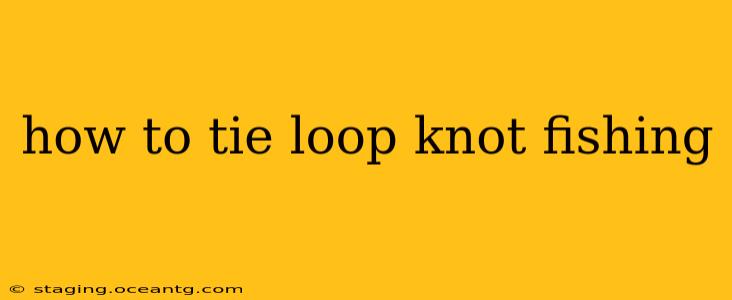The loop knot is a versatile and reliable fishing knot, perfect for creating a loop at the end of your line for attaching lures, swivels, or other terminal tackle. Its strength and ease of tying make it a favorite among anglers of all skill levels. This guide will walk you through tying the loop knot step-by-step, covering various applications and troubleshooting common issues.
Why Use a Loop Knot?
The loop knot offers several advantages over other knot types:
- Versatile: It works with a wide range of line types, including monofilament, fluorocarbon, and braided lines.
- Strong: When tied correctly, it retains a significant percentage of the line's original strength.
- Easy to Tie: The knot is relatively simple to learn and tie, even for beginners.
- Improved Action: The loop allows for a more natural presentation of your lure or bait, enhancing its action in the water.
- Quick Changes: Easily swap lures without retying your entire rig.
How to Tie a Loop Knot: A Step-by-Step Guide
Here's how to tie a reliable loop knot:
- Start with a Length of Line: Measure a length of line approximately 6-8 inches longer than the desired loop size.
- Form an Overhand Loop: Create a simple overhand loop at the end of your line, leaving enough tag end to work with.
- Wrap the Tag End: Wrap the tag end of the line around the standing line (the main line you are not cutting) four to six times. More wraps provide greater security, but too many can weaken the knot. A good starting point is five wraps.
- Pass Through the Overhand Loop: Pass the tag end through the original overhand loop you made in step 2.
- Moisten the Knot: Moisten the knot thoroughly with saliva or water to reduce friction during tightening.
- Gently Tighten the Knot: Carefully pull the standing line to tighten the knot. Hold both the standing line and the tag end while tightening to prevent the knot from slipping.
- Trim the Tag End: Trim the excess tag end close to the knot, leaving a small amount to prevent unraveling.
Troubleshooting Common Loop Knot Problems
My Loop Knot is Slipping:
- Insufficient Wraps: Ensure you've made enough wraps around the standing line (at least four, preferably five or six).
- Incorrect Tightening: Tighten the knot carefully and evenly. Pulling too hard on one part of the knot can cause it to slip.
- Line Type: Some lines are naturally more slippery than others. Try using a knot-enhancing product if necessary.
My Loop Knot is Too Big/Small:
- Adjust the Initial Length: Adjust the initial length of line you measure out to control the size of the loop. More line equals a larger loop.
My Loop Knot is Weak:
- Over Tightening: Avoid over tightening, which can weaken the line.
- Poor Knot Quality: Make sure each step of the process is executed precisely. Practice will help you become more efficient and improve your knot tying.
Different Types of Loop Knots (Optional)
While the above method describes a basic loop knot, variations exist, each with subtle differences. These include the improved clinch knot tied in a loop configuration, providing an alternative suitable for heavier lines or high-stress situations. Researching these variations may prove beneficial based on your fishing setup and preferences.
Conclusion
The loop knot is a fundamental skill for any angler. Its simplicity, strength, and versatility make it a valuable tool in your arsenal. By following these steps and addressing common problems, you can confidently tie this knot and enjoy improved success on the water. Remember practice makes perfect! Keep practicing until you can tie this knot quickly and efficiently.
